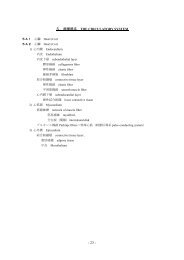Program / Abstract Book - KMU WWW3 Server for Education ...
Program / Abstract Book - KMU WWW3 Server for Education ...
Program / Abstract Book - KMU WWW3 Server for Education ...
You also want an ePaper? Increase the reach of your titles
YUMPU automatically turns print PDFs into web optimized ePapers that Google loves.
No.55 (PM 4)<br />
The inhibitory effect of serum HLA class I antigens on EBV-specific CD8+CTL in<br />
vitro<br />
N.Erdenesuvd 1,3 , B.Gansuvd 1,2 , B.Munkhbat 1,2 , M.Hagihara 2 , T.Hotta 2 , N.Munkhtuvshin 1 ,<br />
1<br />
Central Scientific Research laboratory, Nat’l Institute of Medicine, Mongolia<br />
2<br />
Department of Transplantation Immunology, Tokai University, Japan<br />
3<br />
Dept. Laboratory Medicine, General Hospital, Uvurkhangai, Mongolia<br />
Objectives: The level of sHLA class I molecules in human sera is markedly increased after BM and<br />
organ transplantation, viral infections, autoimmune disorders and cancer. Their biological and clinical<br />
significance has not been fully studied. In the present study the effects of soluble HLA (sHLA) class I<br />
molecules against EBV-specific CTL were examined.<br />
Materials and Methods: Two different sources of sHLA class I, either bioengineered spliced <strong>for</strong>m of<br />
HLA-B7 (sB7) or natural production from EBV-trans<strong>for</strong>med B cells (natural sHLA), were added during<br />
the induction of CTL or incubated with MHC-restricted CD8+ CTL, which were selected by<br />
immunobeads just be<strong>for</strong>e testing <strong>for</strong> their cytotoxic activity.<br />
Results: Both sB7 and natural sHLA class I blocked the generation of CD+ CTL and also inhibited the<br />
cytotoxic activity of established CTL in a dosedependent manner. In both ways, natural sHLA class I<br />
was effective in 10-fold lover concentrations compared with sB7. The inhibitory effect did not require a<br />
shaping of the HLA allotypes between sHLA and the CTL. CTL, after being treated with sHLA,<br />
underwent apoptosis, which was considered here as the main mechanism. Generally, sHLA class I<br />
consists of three different molecular <strong>for</strong>ms: a shedding <strong>for</strong>m with a heavy chain of 44 kD, a splicing<br />
<strong>for</strong>m with a heavy chain of 35 kD and 37 kD. All these molecules are associated with β2-microglobulin.<br />
Also it was reported that membrane-derived, naturally occurring sHLA class I <strong>for</strong>ms multimers through<br />
the ydrophobic<br />
transmembrane tail, whereas cytosol-derived sHLA class I cannot <strong>for</strong>m aggregates. In our studies, the<br />
naturally sHLA class I consisted of all three different molecular <strong>for</strong>ms of HLA-B7.<br />
Conclusion: The naturally occurring sHLA class I induces apoptosis more markedly than sB7. supports<br />
the same suggestion that the membrane -derived naturally occurring sHLA class I could cross-link with<br />
TCR/CD3 complexes via its multimeric <strong>for</strong>ms, and it probably leads to more effective apoptosis of the<br />
CTL. The difference in the biochemical nature of sHLA class I molecules might be the reason why the<br />
inhibitory effect of naturally occurring sHLA class I as stronger than that of sB7.<br />
- 108 -



